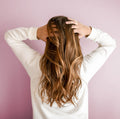A high-quality, deeply hydrating hair mask should only be used once a week. Hair masks are designed to be so moisturizing that you may be tempted to use them frequently. But you must opt out of overusing hair masks.
Using a hair mask more frequently than recommended may cause an oversaturation of oils in the hair, weighing it down and making it appear greasy. Since they are designed to be deeply hydrating, overuse may cause build-up leading to scalp inflammation, itching, or flaking.
Sometimes, if your hair is extremely dry and damaged, a hair mask may be used more than once a week. However, if your hair is extremely damaged and needs deeper care, it's best to proceed with caution. You may want to consult a stylist before implementing hair masking more than is recommended into your hair care routine.


























